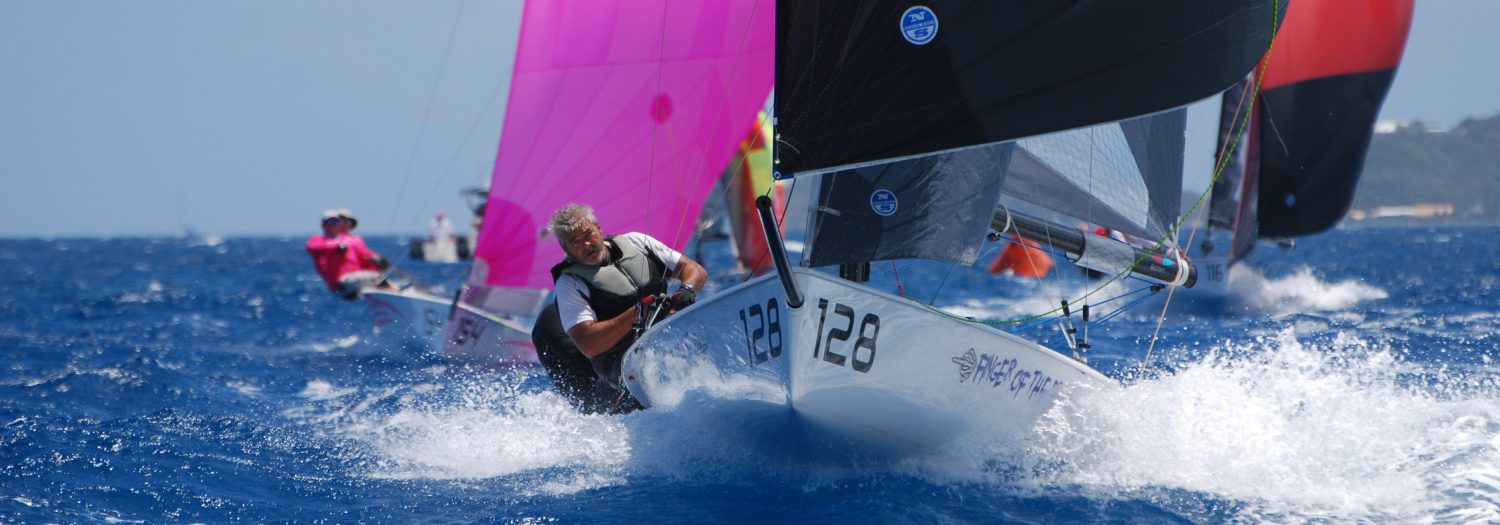After hopping in a VX One for the first time at the 2018 Newport Regatta, I wasn’t sure what to expect. Lucky for me, I had a great crew in Jeff Eiber, whose boat USA 175 we were sailing. He was able to get the initial tuning in place so that I could spend the regatta getting to know the boat and what makes it go fast. Because we had winds from 4 to 15 knots, I got to experience the VX One in a wide range of conditions. What transpired was a lot of falling down in the back of the boat, a lot of getting tangled up in lines, and a whole lot of learning coupled with a whole lot of fun.
“The VX One rewards the fundamentals of sailing” -That’s my catchphrase for this boat. What does it mean? It means that the VX One rewards clear air, good boat handling, clean starts, great boat balance, hard work, and letting the boat talk to you about what it needs – in short, the basics of sailboat racing.
VANG ON
As expected, sailing this boat flat is the key upwind, but you also need to be able to put the bow down. There are two solutions to this problem: Add weight to the rail or pull the vang on and hike. Since the boat is very weight-sensitive and more weight hurts you downwind, the best solution is to use the vang, and a lot of it. On the windiest day, with 15 knots, I pulled the vang as hard as I could get it. This allowed me to ease the sheet to stop the boat from heeling while still maintaining the leech tension for point. Consequently, I was able to put the bow down and get the boat sailing flat while keeping the leech engaged and forcing the boat upwind.
For a short-cord keelboat, the faster you go, the better the foil works, and therefore the boat slides to leeward less, but at the same time the boat also “releases.” By this I mean that it frees up and becomes easier to sail. Small rudder movements do more to change the boat’s direction instead of just creating drag. The mainsheet becomes easier to play because instead of having to dump and trim 6 feet of sheet, you have to play only 1 to 2 feet. The increase in speed powers the boat through waves instead of having the feeling that you’re hitting them and bouncing off. All this means that you can spend more time going fast and less time worrying about your speed relative to other boats. The key to the whole mix is the vang. Whenever I felt the boat bound up, I’d try pulling on a little more vang, and off we’d go again. This was true even in the lighter air.
RIG TUNE
Another piece of the puzzle was the rig tune. Thankfully, Jeff did most of the work here, but by the end of the event, I had asked enough questions that I was starting to understand what he was looking for. In any condition going upwind, he’d start from a base setting and observe the leeward upper. He was looking for it to be just going slack. Then I’d trim the main in harder than I normally would, and we’d look for over-bend wrinkles. Jeff wanted the large wrinkles from the spreader to be traveling about half way down to the clew of the sail. If they extended more than that, he’d tighten both lowers the same amount. If the wrinkles extended less than that, he’d ease off the lowers. This procedure kept the main looking flat enough in the breeze and full enough in light air. As for the base setting, Jeff would always set the boat up for the lightest wind that we were expecting during that particular race.
STAY OUT OF THE BACK OF THE BOAT
Next on my list of things learned was to stay out of the back of the boat. This lesson applied to doing anything, not just normal sailing. It was so easy to get too far back in the boat in a gybe, but that would simply stop us. The same was true for tacks, although they were a bit less critical. Staying out of the back rewarded us with good roll tacks and good roll gybes. And the reward didn’t just come from rolling hard or staying forward. It came from exiting the tack or the gybe at the correct angle so that the boat would power up right away. Upwind, if you’re too low, you’ll give up boat lengths, whereas if you’re too high, the boat will stop. The same concept holds when sailing downwind, but in the opposite direction whereby giving up boat lengths comes from being too high.
FIND A CLEAR LANE
In virtually all sailboat racing, you need to sail in a clear lane, but doing so was particularly important for our VX One. Because we were light on crew weight (350 lbs.), we needed to be very careful about having a heavy boat above us that could roll us or a light boat to leeward with insufficient vang on that was pinching. With a clear lane, we could fall into our bow-down mode, and within three boat lengths, we were the same point as the boats around us, by going faster than they were and in turn sliding sideways less.
In closing, I want to give a plug to the VX One. It’s really fun to sail. Hike hard and try to be as fast as possible all the time, and the boat will reward you in spades. With luck, I’ll get back out on a VX One soon. I’m just hoping that the next time will be in 15+ knots with the spinnaker flying!

